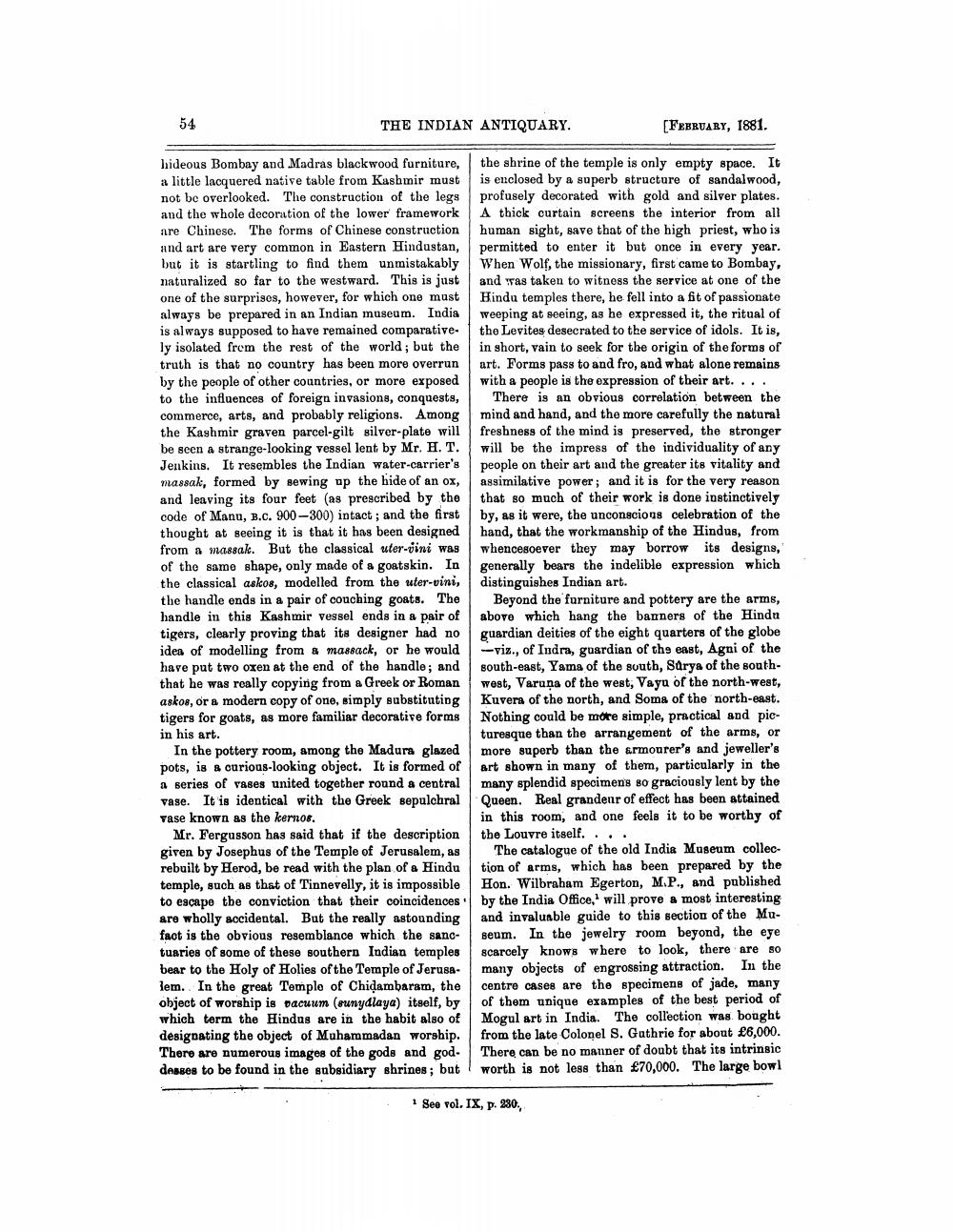________________
54
THE INDIAN ANTIQUARY.
hideous Bombay and Madras blackwood furniture, a little lacquered native table from Kashmir must not be overlooked. The construction of the legs and the whole decoration of the lower framework are Chinese. The forms of Chinese construction and art are very common in Eastern Hindustan, but it is startling to find them unmistakably naturalized so far to the westward. This is just one of the surprises, however, for which one must always be prepared in an Indian museum. India is always supposed to have remained comparatively isolated from the rest of the world; but the truth is that no country has been more overrun by the people of other countries, or more exposed to the influences of foreign invasions, conquests, commerce, arts, and probably religions. Among the Kashmir graven parcel-gilt silver-plate will be seen a strange-looking vessel lent by Mr. H. T. Jenkins. It resembles the Indian water-carrier's massak, formed by sewing up the hide of an ox, and leaving its four feet (as prescribed by the code of Manu, B.C. 900-300) intact; and the first thought at seeing it is that it has been designed from a massak. But the classical uter-vini was of the same shape, only made of a goatskin. In the classical askos, modelled from the uter-vini, the handle ends in a pair of couching goats. The handle in this Kashmir vessel ends in a pair of tigers, clearly proving that its designer had no idea of modelling from a massack, or he would have put two oxen at the end of the handle; and that he was really copying from a Greek or Roman askos, or a modern copy of one, simply substituting tigers for goats, as more familiar decorative forms in his art.
In the pottery room, among the Madura glazed pots, is a curious-looking object. It is formed of a series of vases united together round a central vase. It is identical with the Greek sepulchral vase known as the kernos.
[FEBRUARY, 1881.
the shrine of the temple is only empty space. It is enclosed by a superb structure of sandalwood, profusely decorated with gold and silver plates. A thick curtain screens the interior from all human sight, save that of the high priest, who is permitted to enter it but once in every year. When Wolf, the missionary, first came to Bombay, and was taken to witness the service at one of the Hindu temples there, he fell into a fit of passionate weeping at seeing, as he expressed it, the ritual of the Levites desecrated to the service of idols. It is, in short, vain to seek for the origin of the forms of art. Forms pass to and fro, and what alone remains with a people is the expression of their art. . . .
There is an obvious correlation between the mind and hand, and the more carefully the natural freshness of the mind is preserved, the stronger will be the impress of the individuality of any people on their art and the greater its vitality and assimilative power; and it is for the very reason. that so much of their work is done instinctively by, as it were, the unconscious celebration of the hand, that the workmanship of the Hindus, from whencesoever they may borrow its designs, generally bears the indelible expression which distinguishes Indian art.
Beyond the furniture and pottery are the arms, above which hang the banners of the Hindu guardian deities of the eight quarters of the globe -viz., of Indra, guardian of the east, Agni of the south-east, Yama of the south, Sarya of the southwest, Varuna of the west, Vayu of the north-west, Kuvera of the north, and Soma of the north-east. Nothing could be more simple, practical and picturesque than the arrangement of the arms, or more superb than the armourer's and jeweller's art shown in many of them, particularly in the many splendid specimens so graciously lent by the Queen. Real grandeur of effect has been attained in this room, and one feels it to be worthy of the Louvre itself. . . .
Mr. Fergusson has said that if the description given by Josephus of the Temple of Jerusalem, as rebuilt by Herod, be read with the plan of a Hindu temple, such as that of Tinnevelly, it is impossible to escape the conviction that their coincidences are wholly accidental. But the really astounding fact is the obvious resemblance which the sanctuaries of some of these southern Indian temples bear to the Holy of Holies of the Temple of Jerusa lem. In the great Temple of Chidambaram, the object of worship is vacuum (sunydlaya) itself, by which term the Hindus are in the habit also of designating the object of Muhammadan worship. There are numerous images of the gods and goddesses to be found in the subsidiary shrines; but
The catalogue of the old India Museum collection of arms, which has been prepared by the Hon. Wilbraham Egerton, M.P., and published by the India Office,' will prove a most interesting and invaluable guide to this section of the Museum. In the jewelry room beyond, the eye scarcely knows where to look, there are so many objects of engrossing attraction. In the centre cases are the specimens of jade, many of them unique examples of the best period of Mogul art in India. The collection was bought from the late Colonel S. Guthrie for about £6,000. There can be no manner of doubt that its intrinsic worth is not less than £70,000. The large bowl
1 See vol. IX, p. 230.,




